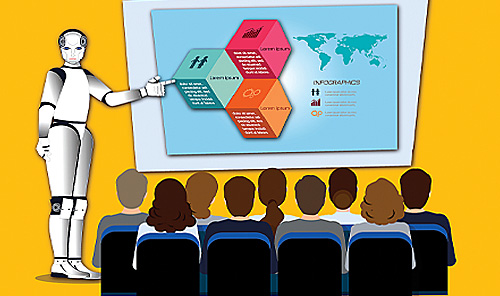In a post-pandemic reality, business operations may look dramatically different. Many people will be forced to transition from one job or career to another. Put another way, there will be an incredible need for workforce development as millions of idled workers return to the workforce. The country’s many workforce programs are ready to get everyone back in the game and have already been adapting their work to the new reality.
To begin with, as much as the pandemic stunned the economy in the first quarter of 2020, “a lot of projects are still proceeding,” says Stephen Moret, president and CEO of the Virginia Economic Development Partnership. And not just projects that were already moving forward as the pandemic first unfolded, he adds. “Companies are making new decisions to expand.”
Moret notes that some industry sectors were hit harder than others by the pandemic, and for some industries, the changing economy has brought opportunities. Cloud computing, for example, which has a growing presence in Virginia, is serving a vastly expanded army of remote workers. “In general, data centers are running full-tilt,” he says. Food-and-beverage manufacturers and logistics companies are also responding to added demand, as more people stay home and cook for themselves.
“A lot of companies are looking to retool their operations to produce personal protective equipment,” Moret adds. That often has a workforce-development component, too.
Brad Neese, vice president of Economic Development at readySC, a division of the South Carolina Technical College System, says the coronavirus pandemic had an impact on his group’s operations almost from the start. “During the COVID-19 crisis, readySC has worked with its partner companies to continue moving forward with training,” he says. “We have helped companies adapt to the requirements of CDC regulations and the unique opportunities offered through online training.”
Though the post-pandemic challenge will be a big one, Neese observes that it’s in keeping with the mission of programs such as his. “Coming out of the crisis, readySC looks forward to helping South Carolinians connect to employment opportunities with expanding and newly located companies,” he says. “We will continue to connect companies with our colleges across the state to help train incumbent workers, build back capacity for existing businesses, and ensure a continuous pipeline of skilled workers for the future. At the end of the day, we are a system dedicated to enhancing workforce and economic development in the state. It’s a comprehensive, holistic solution that works.”
In a post-pandemic reality, business operations may look dramatically different. “The situation Alabama and the entire country are facing is truly unlike anything we’ve ever seen,” says Ed Castile, Alabama’s deputy secretary of Commerce for the Workforce Development Division and executive director of Alabama Industrial Development Training, about the pandemic’s impact. He says a typical economic downturn causes much more gradual changes to the employment picture, while the pandemic collapse has required a more day-by-day response. “The one thing we’re certain of is that when this is under control, we will be ready to help our citizens and our companies return to full employment and full production capacity very quickly.”
Workforce Is Not a New Concern
Of course, it didn’t take a pandemic to put workforce development high on the list of concerns facing businesses. The ability to locate and hire the right workers — and train them as necessary — has been a major business concern for a long time. “Companies want to know they will be able to find the right number of employees with the right skills and/or the ability to obtain those skills,” Neese says.
“The availability, quality, and cost of talent has become the dominant driver in location decisions,” says Moret. It always was important, he says, but in recent years became even more pronounced, as jobs have become more dependent upon education and the development of specialized skills.
Castile says the biggest concerns companies have been bringing to his organization — at least before the pandemic stunned the economy — have included labor availability, workforce sustainability, and technical skills. “We were approaching workforce shortages prior to the recession in 2009–2010,” he recalls. “The Great Recession changed the dynamic. It took several years to get the people back to work because of a complete contraction of the economy. We were facing some of the same workforce availability issues right before the COVID-19 pandemic.”
Neese says the same thing about South Carolina. “Like much of the U.S., South Carolina saw record low unemployment, which some companies perceived as a potential barrier to finding talent,” he says. Workforce development through readySC made a significant difference, helping companies meet or exceed recruitment goals even in a low-unemployment-rate environment.
And even without the current economic challenges, the labor market has been in a period of evolution that has necessitated an increased focus on workforce development efforts, Neese says. “While the landscape is somewhat unknown based on the impact of the pandemic, we have the tools to continue ensuring our existing and future industries have the workforce necessary to find success within our borders.”
Even without the current economic challenges, the labor market has been in a period of evolution that has necessitated an increased focus on workforce development efforts. Connecting Employers with Qualified Workers
How does workforce development work most effectively? There are a lot of examples from the Southeast, where just about all of the country’s most highly ranked workforce development programs can be found. As Moret points out, “Southeast States have tended to promote economic development as an activity more than some other parts of the country.” Here are some examples:
Virginia: The Virginia Talent Accelerator is a turnkey solution for customized recruitment, screening, and training, according to Mike Grundmann, senior vice president of Talent Solutions at the Virginia Economic Development Partnership. Services are provided at no cost to qualifying new or expanding employers. Meanwhile, the Virginia Jobs Investment Program offers consultative services and funding to companies that are creating new jobs or experiencing technological change. Through Virginia’s workforce initiatives, Grundmann says, “our goal is to shorten the new-hire learning curve.”
Georgia: The Georgia Quick Start program has been around for more than four decades and was the first of its kind in the country. Connected with the Technical College System of Georgia, it has trained more than a million workers, through programs tailored to the needs of the employer.
Louisiana: LED FastStart is also a highly rated workforce training program. It offers no-cost, customized employee recruitment, screening, training development, and training delivery. The program employs expertise from a wide range of businesses to offer an edge to qualified new and expanding companies.
Alabama: AIDT is Alabama’s workforce training agency, offering a range of job-specific services for pre-employment and on-the-job training. It provides recruitment, assessment and training services, develops training materials, and offers training facilities. “AIDT is in the company-specific recruitment and training business,” Castile says, and “we have ramped up everything to reflect the growing needs.”
South Carolina: The readySC program offers recruiting, assessment, training development, management, and implementation services, Neese says. On a typical day, the program is working on more than a hundred projects across the state. Other programs include ManuFirstSC, which provides certification that entry-level talent meets minimal manufacturing experience requirements. Neese also points to South Carolina apprenticeship programs and a statewide technical college scholarship program.
Tennessee: Several programs and initiatives have earned this state accolades for workforce development. Workforce360° is a systematic partnership among state agencies and the higher education system, a project-based system targeting workforce gaps. The Labor Education Alignment Program follows a data-driven approach to be sure postsecondary institutions are delivering what businesses need from a skills perspective. And a series of programs aims to make postsecondary education affordable to all residents.
North Carolina: The statewide workforce system here is known as NCWorks, and like other highly rated programs, it has a range of free services and programs for expanding businesses. NCWorks includes recruiting services, job training assistance, apprenticeship programs, and special services related to the agricultural workforce.
Getting Workforce Results
AIDT has helped enable a wealth of economic investment in Alabama, Castile says. Just one example is assistance it has provided for Mercedes-Benz U.S. International. “We’ve worked closely with MBUSI, one of our long-term partners, to help establish a new supply chain for electric vehicles. We’re working through new skills and needs for suppliers for this new vehicle,” he says. “In addition, we’re working to get Mazda Toyota Manufacturing and their new joint venture moving forward.”
Neese cites work with Quality Electronic Manufacturing Services (QEMS), which moved to South Carolina in 2018. “A big reason for the decision to move was support from readySC for our future business growth,” according to the company’s CEO, Phuong Nguyen.
One hallmark of the country’s leading workforce programs is an openness to tackle new issues as they are identified. “We’re working specifically with one of our workforce regional partners to remove all roadblocks to getting people to work, including transportation issues and childcare issues,” Castile says. “There are multiple opportunities to remove roadblocks to employment. We just have to identify the best solutions to these issues and make sure they actually help our citizens.”
Workforce-Development Tools in Action
Even before the pandemic hit, Americans were buying more and more things online for home delivery. Michigan-based Morgan Olson makes walk-in delivery vehicles that help enable those online purchases, and the company has been needing to expand its manufacturing capacity to keep up with demand.Meanwhile last summer, Ikea announced plans to shutter its 925,000-square-foot manufacturing plant in Danville-Pittsylvania County, Virginia. The move would cost 300 jobs in an area already hard-hit by the loss of textile manufacturing. State officials quickly made the connection between Morgan Olson’s need for manufacturing space and Danville’s need for replacement jobs. Stephen Moret, president and CEO of the Virginia Economic Development Partnership, referred to it as “a real Hail Mary pass,” and in October the state caught the pass for a touchdown — a $57.8 million investment by Morgan Olson worth hundreds more jobs than what Ikea left behind.
Mike Grundmann, senior vice president, Talent Solutions at the Virginia Economic Development Partnership, says a key to making it work is the Virginia Talent Accelerator Program, a workforce initiative created by VEDP in collaboration with the Virginia Community College System. The program provides company-specific recruitment and training services at no cost to qualified new and expanding employers, and that helped seal the deal for Virginia.
Indeed, the company said as much in making its plans public. “One of the most attractive aspects of locating in Danville-Pittsylvania County is that we will be able to take advantage of the new Virginia Talent Accelerator Program, which will help us quickly attract and train the high-quality workforce we need to deliver for our customers,” said Mike Ownbey, president and CEO of Morgan Olson.
Within a month of the announcement, Grundmann reports, Morgan Olson was interviewing former Ikea employees to fill professional staff positions. At about the same time, expert instructional designers from the Virginia Talent Accelerator Program and Danville Community College traveled to a Morgan Olson plant in Tennessee to study processes, best practices, and training needs to apply in Virginia. They returned to Tennessee later to get video of assembly workers in action, to help create training programs.
Following a series of job fairs, the program conducted two weeks of pre-hire training that included an introduction to riveting, measuring, and other assembly procedures. It was a preview for future workers and an opportunity for the company to get a first look at candidates’ potential performance before making final commitments. Supplementing the manufacturing training was a Leadership Academy for supervisors and team
leaders. Post-hire training classes began in mid-March 2020, as the company moved toward the launch of production this summer, less than a year after Ikea announced its plans to depart. Workforce development efforts helped that Hail Mary pass turn into a championship win for the company and community alike.




